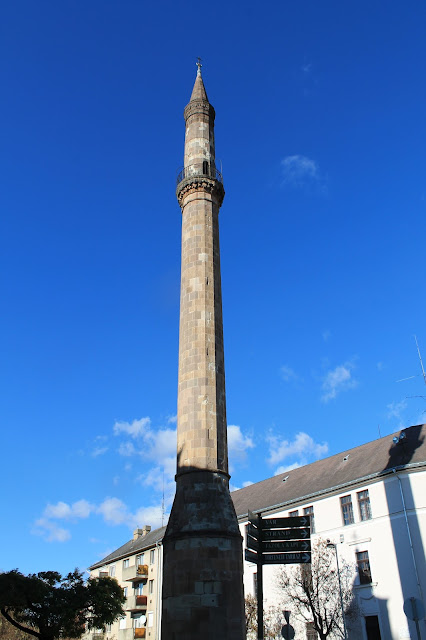 |
| The Minaret of Eger (seen from a safe distance!) |
I'm climbing steadily, back wedged against the curved wall, hands pulling me up the tiny, worn-smooth steps that spiral above me. This is terrifying. I'm inside the Minaret of Eger, a survivor from the Ottoman occupation of the city in the 17th century. It's basically a 40 metre-high sandstone tube, the diameter barely enough to fit through. There's 97 steps to the top, but it seems like more when the windows are thin slits and the electric lights are sparse. Both ascent and descent are a nerve-shredding experience. I'm promised stunning views out of over the city. When I reach the viewing platform, it is a flimsy-seeming balcony of rusty metal that I hardly dare step onto, let alone walk around. The panorama is impressive, but the vertiginous drop to the street below sort of eclipses that. (To be fair, their website does warn the visitor of all of the above... but I failed to read it beforehand!)
 |
| The view from the minaret balcony. Just don't look down. |
I'm not superstitious, but there is something almost supernaturally intimidating about the minaret. Despite defeating the Turks in 1552, Eger pretty much surrendered in 1596 when the Ottomans returned. Mosques and baths were built across the city, but when the Hungarians retook this strategic outpost in 1687, most of these buildings were destroyed. The minaret is the resilient exception. Apparently, 400 oxen were employed to pull down the tower, but still it endured, aided by its rare tetradecadon base. The Christians assuaged their defeat by placing a cross on the pinnacle. It is now the northernmost minaret in Europe.
The lady who sells me the entrance tickets asks for my visit to be 15 minutes maximum. I have no problem with this, spending just a few minutes at the top before the vertiginous clamber down. Later, talking to a local, I say that the minaret - though architecturally and historically impressive - manages to combine an array of phobias: claustrophobia on the staircase, agoraphobia when you reach the balcony and stare out over the city, and vertigo as you dare to glance down. "And arachnaphobia!" he adds. "In summer, the staircase is full of huge spiders!" Eek.
 |
| Macok's wine wall - a more soothing spectacle. |
Fortunately, to ease my fear-tensed muscles, not far from the minaret there is the wonderful restaurant of Macok. Widely regarded as the best restaurant in Eger, it more than lives up to its reputation (booking is definitely advised - we arrived at 12 when it opened, and it was full within 20 mins). Many restaurants aim for the 'Hungarian classics with nouvelle twist' but Macok more than succeeds. The decor is beautiful (check out the 'wine wall'), the service attentive and the food is gorgeously presented, delicious and well-balanced. I have a starter of trout roulade, my partner a cheese fondue that begs to be shared. My main of toasted rabbit with potato dumplings is perfectly tender and dodges the stringy quality of many a lapin dish.
And if the fine foods and wines of Macok don't completely erase my minaret-terror, a visit to Eger's thermal baths certainly do. With a Turkish bath and newer indoor and outdoor pools, the architectural highlight is the domed, contemporary poolhouse designed by 'organic architect' Imre Makovecz. He defied the brutalist, blocky style of Soviet Hungary to create what he termed 'building beings', curving arches that resemble tree boughs, oval windows that look like owl-eyes. Lazing back in 37 degree spring water, his Eger poolhouse harmonises perfectly with the trees in the park around us. A great counterpoint to the more intimidating architectural feat of my morning.
 |
| Imre Makovezc's Eger poolhouse. (Photo courtesy of Helen Betts) |


Love the review :)
ReplyDeleteLove the humour in the reveiw :)
ReplyDeleteA joy to read. Inspired to visit. Thank you.
ReplyDelete